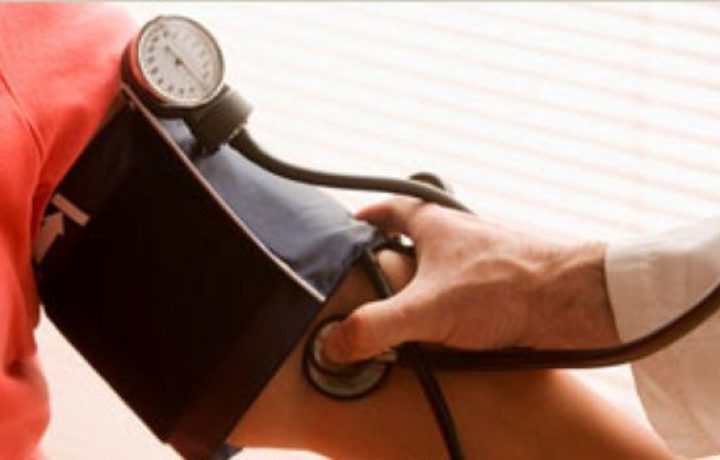Description
* High blood pressure or hypertension affects 50 – 60 million Americans today and is one of the leading causes of stroke.
* Blood pressure (BP) is measured at the top of the arm, as this is the closest measurable artery to the heart, with a sphygmomanometer and is represented by a ratio of two numbers – systolic and diastolic. The systolic pressure is the first measurement, representing the pressure in the arteries when the heart is contracting. The diastolic pressure is the second measurement representing the pressure in the arteries when the heart is at rest.
* Normal BP for an adult is somewhere around 120/80, although this is not necessarily so for all people. It is safe to say that the lower the BP the less likely it is that you will suffer heart problems, unless of course it is too low.

Causes
* There are two categories of hypertension, and each is attributable to different factors, although common factors may exacerbate the condition.
- The causes of primary or essential hypertension is not well understood, except to say that it is not caused by another underlying condition. Factors that may contribute to it include smoking, high salt intake, use of stimulants such as alcohol, drugs, coffee and tea, obesity, genetics, stress and the use of birth control pills.
- The causes of secondary hypertension include arteriosclerosis, atherosclerosis or kidney problems.
Symptoms
* Hypertension is often called the silent killer, as there are few symptoms in its early stages. As the condition progresses, symptoms such as headaches, dizziness, nosebleeds, a fast pulse, shortness of breath, sweating and confusion may occur.
Lifestyle symptoms
* Stress Management – techniques including yoga, meditation and breathing exercises on a daily basis, as well as massage and acupuncture are known to reduce stress levels. As part of a successful stress management plan, you need to look at the underlying factors that cause stress and try to resolve these situations.
* Exercise – should be a part of a plan to reduce weight and stress levels. It is known that a moderate level of fitness and exercise may reduce blood pressure, however, please consult your physician before you undertake any form of exercise if you have high blood pressure. Sudden strenuous exercise may exacerbate hypertension.
* Quit Smoking – smoking is one of the major risk factors in developing atherosclerosis, it increases blood pressure and increases the blood’s tendency to clot. Acupuncture and nicotine patches have been found to be somewhat effective, however strong will power and going ‘cold turkey’ is the most successful method. Above all, smokers need to want to quit. See smoking for information on how to quit.
* Address Obesity Problems – obesity puts unnecessary strain on the body and heart, and causes changes in blood lipoprotein levels that increase the risk of atherosclerosis and hypertension.
* Diet Changes – diet is one of the easiest ways to have a positive effect on blood pressure.
If you have high blood pressure you may consider the following:
- Adopt a vegetarian diet – vegetarians in general are known to have lower incidence of blood pressure, cholesterol and other cardiovascular diseases.
- Eliminate salt – salt in its numerous forms, are known to increase blood pressure. Avoid or eliminate products such as salt, sodium, anything with the ‘Na’ symbol on it, MSG, baking soda and any product containing baking soda and prepackaged food unless it is labeled salt free.
- Avoid phenylalanine, aspartame, tyrosine and any product that contain these, such as diet soft drinks and sweeteners. Avoid all animal products, soy sauce, chocolate, alcohol, caffeine products, meat tenderizers, mold inhibitors and medications containing ibuprofen and antihistamines.
- Take in plenty of fresh fruit and vegetables, ensuring that you consume enough vegetable protein and potassium. Include foods such as celery, onions, apples, bananas, dates, figs, yams, blackstrap molasses, apricots, tomatoes, wheat bran, raisins, leafy green vegetables, cold pressed vegetable oils such as flaxseed oil and olive oil, melons, garlic, sweet potatoes, brown rice, oats and buckwheat.
Treatments for hypertension:
* Current conventional treatment relies upon drug therapy to lower blood pressure and often little attention is paid to the patient’s lifestyle. There is currently some debate over the prescription of conventional drugs for borderline to moderate hypertension cases, which is about eighty percent of all cases. Substantial evidence is shown in some studies that many non-drug therapies such as diet, exercise, and relaxation have proven superior to drugs, in cases of borderline to mild hypertension.
- Furthermore, there is increasing evidence that in some people these drugs produce unnecessary side effects such as fatigue, headaches, impotence and increased risk of heart disease.
- Taking this into consideration, it may be appropriate to have hypertension diagnosed by a nutrition oriented physician who is able to offer you a range of therapies. If your hypertension is in the borderline to moderate range (approximately 120/90 – 140/105), you may consider a range of natural therapies including acupuncture, reflexology, diet and other lifestyle changes, yoga, meditation and herbal remedies.
Note that severe hypertension often requires immediate conventional drug therapy, and that natural therapies may also complement this. It may be possible that after some time the drug therapy may be reduced, however this will require close medical supervision.
SEE:

VITAMIN E – an antioxidant that protects the cardiovascular system. Natural sources of vitamin E include nuts, sunflower seeds, wheat germ, asparagus, peas, soy lecithin, dark green leafy vegetables, brown rice, kelp, oats, sweet potatoes, alfalfa, and rose hip. 400 iu daily in divided doses may help. Take according to label instructions if you suffer from diabetes, overactive thyroid, or are taking anticoagulant medication.
CALCIUM – reduces cholesterol levels, blood pressure and may prevent heart disease. Natural sources of calcium include molasses, tofu, leafy green vegetables, soy beans, almonds, broccoli, brewer’s yeast, carob, dandelion, figs, chamomile, flaxseed, parsley, peppermint, alfalfa and sesame seeds. 1,500 – 2,000 mg daily in divided doses may help. Seek medical advice before taking calcium if you suffer from hyperparathyroidism, kidney disease or sarcoidosis, or if you are taking a calcium channel blocker for heart problems or high blood pressure. Increased calcium intake may require increased magnesium intake.
MAGNESIUM – assists in calcium absorption, helps to protect arterial linings from changes in blood pressure and may lower cholesterol levels. Natural sources of magnesium include garlic, leafy green vegetables, alfalfa, fenugreek, lemongrass, apples, bananas, parsley, peppermint, tofu, soybeans, sesame seeds, peaches, brown rice, cantaloupe and blackstrap molasses. 800 – 1,200 mg daily in divided doses may help. High doses of magnesium may cause diarrhea. Consult your physician before taking magnesium supplementation if you have kidney disease.
SELENIUM – selenium deficiency has been linked with heart disease and high cholesterol. Natural sources of selenium include wheat germ, brewer’s yeast, brown rice, fennel seed, fenugreek, garlic, molasses, onions, lemongrass, kelp, broccoli, alfalfa, and peppermint. 150 mcg daily may help.
KELP – important for healthy blood vessels. Take according to label instructions or eat raw.
GARLIC – lowers blood pressure, thins the blood, dilates the walls of blood vessels. Take 2 – 3 capsules daily. Consult your physician before taking garlic if you are on heart medication.
CAYENNE,CAPSICUM, RED PEPPER, HOT PEPPER. – improves circulation. Take according to label instructions.
HAWTHORN – lowers cholesterol, dilates walls of coronary blood vessels. Take according to label instructions. Note that excessive amounts can be dangerous as it may depress respiration and heart rate.
KAVA KAVA – helps to relieve stress. Take according to label instructions. May cause drowsiness.
ROSEMARY – helps to normalize blood pressure and is used for circulatory problems. Use according to label instructions or eat raw. Do not use essential oil for high blood pressure.
LAVENDER – essential oil used in massage or oil burner will help calm a person which will in turn reduce stress. Note that only pure essential oils should be used .Synthetic imitations have no healing properties and can be toxic.
YLANG YLANG – essential oil is used to reduce high blood pressure. Massage onto body in carrier oil. Essential oil should equal three percent of total oil content.
